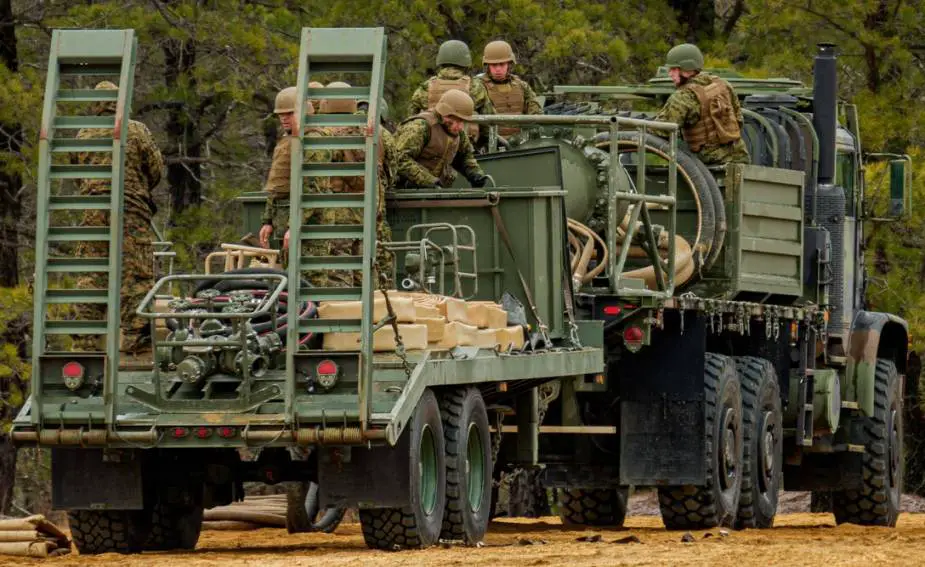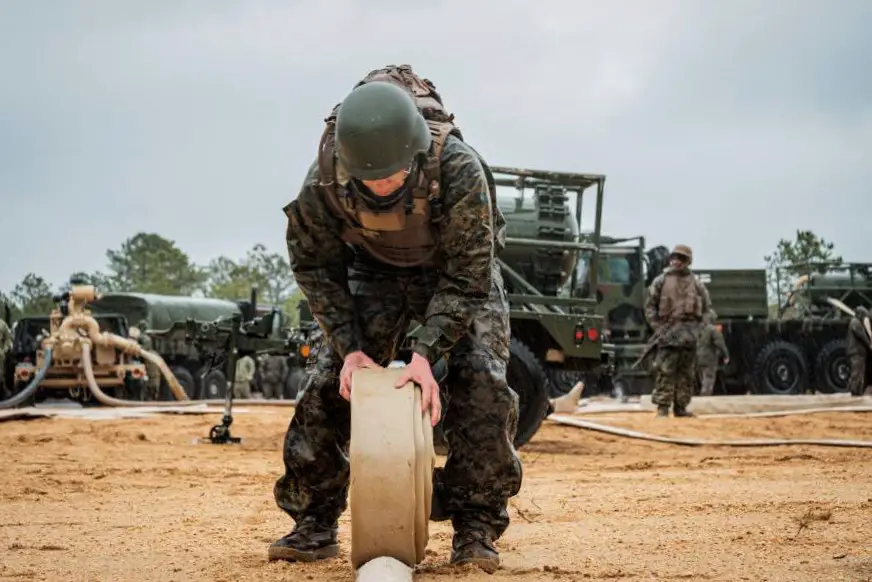Breaking news
US Marine Corps Commands developing Expeditionary Fuel Dispensing System.
Although the United States has enjoyed an asymmetrical logistical advantage since the end of World War II, emerging needs associated with the sustainment of fuel requirements in future battlefields have presented challenges for military leadership and the warfighter alike. Johannes Schmidt, U.S. Marine Corps Systems Command, elaborates.
Follow Army Recognition on Google News at this link

U.S. Marines with 6th Engineer Support Battalion Bulk Fuel Company B, 4th Marine Logistics Group, load gear on a vehicle at Joint Base McGuire-Dix-Lakehurst, New Jersey, Mar. 12, 2022. The 6th ESB Bulk Fuel Company B focuses on innovating and experimenting on Expeditionary Advanced Base Operations. 6th ESB focuses on innovating and experimenting on Expeditionary Advanced Base Operations (Picture source: U.S. Marine Corps/Cpl. Ryan Schmid)
U.S. Marine Corps Systems Command’s Fuel and Water Team recently initiated efforts to develop the Expeditionary Fuel Dispensing System, which provides increased battlefield flexibility to Marines. Also known as EFDS, the new program of record reconfigures capabilities existent in legacy fuel systems, such as the Amphibious Assault Fuel System – AAFS -- and the Tactical Airfield Fuel Dispensing System – TAFDS -- into smaller, more agile expedient capabilities.
“EFDS allows Marine Corps Systems Command to replace legacy systems,” explained EFDS Lead Logistician Linnis Hobbs. “It increases expeditionary capabilities by allowing the Bulk Fuel Marines to choose between a small, medium or large containerized system.”
Although the EFDS can still handle large amounts of fuel, the system enables commanders to select tailored bulk fuel capabilities instead of having to employ large, cumbersome legacy fuel systems while executing missions in distributed operational environments. “We're looking at a much smaller footprint. EFDS allows us to take a 1.1-million-gallon fuel farm and break it down into much smaller pieces,” said EFDS Project Officer Master Sgt. Vidal Rojas Giron. “It really makes things much more manageable.”
As Russian logistical failures during the earliest days of the Kremlin’s invasion of Ukraine have demonstrated, the decentralization of fuel systems – and the elimination of “liquid mountains” – is a necessary capability in a world where rival powers have access to precisions weapons systems. "We're looking at a much smaller footprint. EFDS allows us to take a 1.1-million-gallon fuel farm and break it down into much smaller pieces”, said EFDS Project Officer Master Sgt. Vidal Rojas Giron.
"Unlike the logistical buildup seen in past conflicts, our competitors -- as named in the recently released National Security Strategy -- can identify our ‘liquid mountains’ with their ISR assets and range us with their weapon system capabilities. Understanding that fuel is the pacing commodity, EFDS enables the fleet commander to understand the mission they have been assigned and then select their equipment sets to fit that specific scenario while operating and sustaining inside the enemy’s Weapons Engagement Zone,” explained Maj. Craig Warner, project team leader of the Fuel and Water Team.
To expedite the fuel systems modernization efforts, MARCORSYSCOM’s Program Manager Engineer Systems recently teamed up with II Marine Expeditionary Force, Marine Corps Logistics Command and Marine Force Storage Command to conduct an inventory of all AAFS and TAFDS bulk fuel assets located in storage at Marine Corps Logistics Base Albany, Georgia.
Between Aug. 22 and Oct. 22, 2022, Marines from II MEF came together to inventory and inspect legacy fuel systems to determine if the equipment is viable to fill Fleet needs and improve readiness, while simultaneously informing the acquisition strategy development for the EFDS – demonstrating the power that exists when various Marine Corps commands collaborate and function together to provide key support for the Fleet Marine Force.
“Since there was excess equipment in storage at Albany, the MARCORSYSCOM Program Office briefed LOGCOM and Marine Corps Storage Command about the need to transfer equipment for the upcoming EFDS efforts,” explained Hobbs. “We knew that this effort couldn’t be done alone and required a large number of resources. A lot of the manpower was provided by LOGCOM -- civilians and uniformed personnel -- and II MEF Marines from 8th ESB, 2nd Maintenance Battalion, Marine Wing Support Squadron 273, and MWSS-272.”

Pfc. Khalil Wakeem, a bulk fuel specialist with 6th Engineer Support Battalion Company B, 4th Marine Logistics Group, rolls up a hose at Joint Base McGuire-Dix-Lakehurst, New Jersey, Mar. 12, 2022 (Picture source: U.S. Marine Corps/Cpl. Ryan Schmid)


























